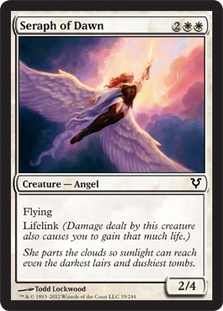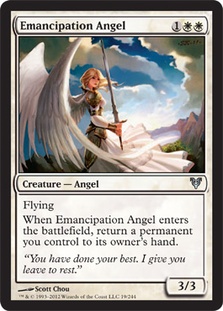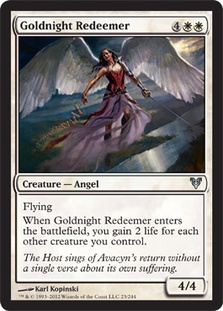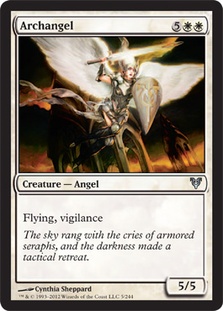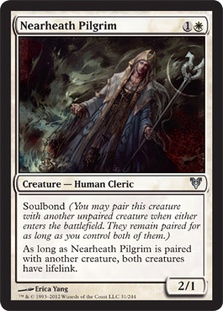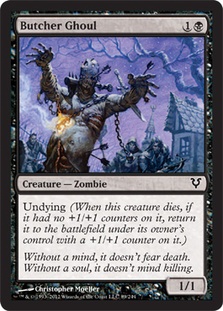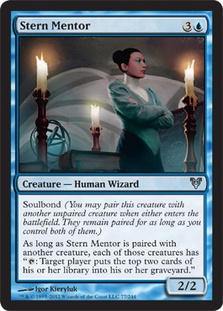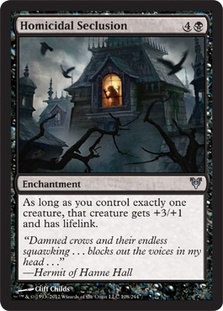WARNING!
This article contains hot new tech relating to the Avacyn Restored Draft format. It is not suitable for all viewers. Specifically, if you are going to the Pro Tour in Barcelona next week, do not—I repeat, do NOT—read this article. The author would much prefer you remain ignorant of its contents is obliged by law to inform you that it may cause birth defects, male pattern baldness, and cheetah attacks.
Exposure to tech can only be avoided if you follow these instructions carefully:
1. Don’t scroll down.
2. Did you scroll down?? You did! Stop that, right now!
3. Still here? Good. Don’t let me catch you doing that again.
4. Now, scroll down.
…
…
…
5. Keep scrolling until you see another set of three ellipses, just like those above. That indicates you’re out of the danger zone and can enjoy an entertaining joke about Zombies.
6. Enjoy!
#5: Angels
What they look like: Slow, expensive, undeniably powerful.
What they are: Bombs.
The Angels are number five on this list because, well, it’s pretty obvious that they’re good. What might not be obvious is exactly how good they are. It turns out that the Avacyn Restored Draft format has a curious characteristic: card quality is overall lower than it has been in most recent sets.
If you’re a dinosaur like me, you remember drafting way back when in Onslaught block. Now, OLS certainly had its share of powerful cards, and there aren’t many who remember Sparksmith or Timberwatch Elf fondly. But if you took your average Onslaught draft deck and played it against your average Innistrad draft deck, the Innistrad guy would win 75% of the time.
Why? Simply, there used to be a lot more filler and downright awful cards in packs. These days we take for granted that we’ll wind up with 27 playables and trim it down to a lean, mean, synergy-laden machine. Thraben Purebloods, a reasonable if clunky body, was widely considered unplayable. Moriok Reaver frequently went 13th—Lone Missionary as well. Back in Onslaught, if the colors hadn’t been flowing you’d kill for a Moriok Reaver. It was commonplace to play off-color morphs to fill out your deck; even off-color cycling spells, if you were desperate.
The effect this had was to make the powerful, clunky, game ending spells better than the always-useful utility removal spells. Pick one, pack one, a seven mana 5/5 flier was the pick over Shock. If I have some random Gray Ogres and Hill Giants and you have some random Gray Ogres and Hill Giants, a Shock won’t break the stalemate. It’ll be good, but it won’t have the same game-swinging potential as a Dragon Mage.
Back to Innistrad—how many of you have taken Brimstone Volley over Balefire Dragon? In most situations, it’s absolutely the right pick. In this case, both decks are generally high-quality cards with a lot of synergies. A key removal spell that allows you to take out their Skirsdag High Priest + Stitcher’s Apprentice setup or simply race their turn 1 Delver of Secrets is more valuable than a seven-drop which may or may not be Silent Departured.
As for Avacyn Restored, let’s put it like this: if Thraben Purebloods was in Avacyn Restored, almost every white deck would play it. Common power creep has been scaled way back. I should emphasize that this isn’t necessarily a bad thing. It makes paying attention to signals more important. Synergy still matters; you just have to work harder for it. But the major effect on drafting is to make the expensive game-winners better at the expense of the utility commons.
All of this is a long-winded way of saying: take big fliers! I also strongly recommend pairing Plains with white spells and holding your knife by the non-pointy end. But seriously, to those who’ve just come off a diet of Innistrad, it might not be obvious how much better Seraph of Dawn is than Death Wind. Hint: don’t think about which one is better when they curve awesome threats into double Silent Departure. Think about which one you’d rather have facing down a couple 2/2s and a 3/3.
#4: Tandem Lookout / Nearheath Pilgrim
What they look like: Ok dudes with weird abilities.
What they are: Aggressively costed mashes between an efficient dude and an awesome equipment.
It’s no secret that Hanweir Lancer and Trusted Forcemage are good Limited cards. I’d happily pay three for a 3/3 or a 2/2 first striker in Limited, and these guys are that but with upside? Sign me up!
Tandem Lookout is somewhat more of a secret. A three-mana 2/1 Ophidian is a pretty awful Limited card, so it’s not immediately obvious how great this guy really is. But the Ophidian text on him is only a fraction of it—the strength of the card is the ability to give it to any guy you choose.
Imagine turn 2 Kruin Striker into the Lookout. You’re up at least one card straight off the bat and more if they missed a drop. Even an Alchemist’s Apprentice can get a sneaky hit in on the play, before he trades himself in to let Mist Raven take up the Lookout mantle.
Yes, fliers can turn into Ophidians too, and that’s the real draw to the card. The real card draw, even. (Ho ho.) While Tandem Lookout only infrequently gets in a hit, it forces them to leave a guy back, which is relevant. Meanwhile, the Mist Raven he’s married to draws cards to her heart’s content. If you ever draw three or more cards off this guy you’re hard pressed to lose the game, and that can happen as early as turn 5.
Nearheath Pilgrim is similar, but instead of drawing five extra cards you get to gain fifteen extra life. Early in the game, Nearheath Pilgrim will pair with some random guy like a Farbog Explorer, who’ll trundle in for four to six points of lifegain. Later on, she’ll get bored of him. “What was I thinking?” she’ll ask herself around turn 6. “I thought Swampwalk was such a manly ability, but all he’s done for three turns is mope around and stare at that Nettle Swine.”
Luckily, Nearheath Pilgrim is always looking to trade up, so send that Farbog Explorer in to die and upgrade him into a Voice of the Provinces. Yes, it turns out the Pilgrim swings that way too, and it’s even legal in Massachusetts. She’s not quite at the level of Islamic Forcemage, who can pair with seventy-two Angels from the graveyard, but a 3/3 flying lifelinker still beats down hard. Pair ’em up, son.
#3: Butcher Ghoul
What he looks like: A bad card. Young Wolf was only ok, and Butcher Ghoul costs twice as much?!
What he is: An important piece for almost every black deck.
Pop quiz: what do Bone Splinters, Bloodflow Connoisseur, and Barter in Blood all have in common? Apart from that they go in the alphabet Block deck with Blood Artist, Bloodline Keeper, and Black Cat.
That’s right—they all want you to sacrifice creatures. Luckily, Butcher Ghoul starts with B as well just so happens to be into that kind of thing. And it’s a good thing too: beyond Butcher Ghoul, black has a shortage of guys that work well with its sac outlets. Undead Executioner is fine, but Driver of the Dead is only great if you have a Butcher Ghoul or two to start out with and Polluted Dead is expensive and bad.
And it’s just like in Innistrad, where you’d play four Armored Skaab and one Makeshift Mauler but never one Armored Skaab and four Makeshift Mauler. The enablers are more important than the cards that take advantage of them. If you draw Butcher Ghoul and Undead Executioner without Bloodflow Connoisseur, they’re at least going to hold the ground well. If you draw Bone Splinters and Bloodflow Connoisseur without Butcher Ghoul, you can, uh, two-for-one yourself for four mana I guess.
Let’s get one thing straight—Butcher Ghoul itself is not a good card. However, like any great synergy piece, it makes all your other cards better. Every black deck I’ve seen in this format wants a couple of Butcher Ghouls, and if it’s pack 3 and you don’t have any, you might have to grab one over Grave Exchange. It’s not fancy, but it does what needs to be done.
Don’t believe me? Imagine, if you will, a hand of Bone Splinters, Bloodflow Connoisseur, Driver of the Dead, and four lands. Not a great draw I’m sure you’ll agree. Now replace one of those lands with a Butcher Ghoul. See my point?
#2: Stern Mentor
What it looks like: The return of Merfolk Mesmerist.
What it is: A legitimate—scratch that, terrifying—win condition.
So you’re playing the U/W mirror. It’s turn 12, and you’re bogged down in Angelic Walls, Defangs, and Seraph of Dawns. He’s still on 20, and your life total is creeping slowly up towards 40 as Seraph pokes away.
You’re not worried. My deck has two Amass the Components left in it, you think, and sooner or later I’m going to draw that Herald of War or my Archangel. His board of Galvanic Alchemist, two Angelic Walls, and a Defanged Goldnight Redeemer? It’ll last maybe a few turns.
That is, until he draws a card; his face lights up. He reaches over to count your library and then drops the elbow: Stern Mentor, pairing with Galvanic Alchemist, six mana up. Ship it.
That’s right. All it took was an oft ignored uncommon to turn a board well in your favor into a total rout. Mill for six, untap, mill for ten. It doesn’t matter what you drew. You didn’t have any outs.
“Well sure, Jeremy,” you’re probably saying, “but that’s an exceptional circumstance. Two slow decks, board stalled, and he even had the combo in Galvanic Alchemist. In a normal game, there’s no way that Stern Mentor ever amounts to more than a four-mana 2/2.”
An excellent point, as always Mr. Straw Man. However, I must beg to differ. Four cards a turn? Let’s do the math: by turn 4, your opponent will have 29 cards left in their deck. That means six activations, maximum, will deck them. Often five, if it’s a turn or two later or they’ve drawn some cards, given Mentor effectively CIP mill-twos them.
Five activations. Eat your heart out, Vedalken Entrancer. That’s the same clock as a 4/4 flier.
Now granted, Stern Mentor doesn’t come with a good body, and its kill condition doesn’t work with the rest of the cards in your deck (unless you drafted a bunch of Dreadwaters, which I would not recommend). That said, any alternate kill this efficient has to be respected. I would never cut Stern Mentor from a draft deck, and I would actively look to pick them up if I had Angelic Walls or similar. Over the course of three rounds, it’ll win you at least a game or two.
It can even be an advantage for your win condition to ignore damage. Your opponent might have:
#1: Homicidal Seclusion
What it looks like: Some weird five-mana enchantment.
What it is: Loxodon Warhammer.
Dan Unwin: “So are you at the point yet where you take Homicidal Seclusion over any common or uncommon?”
I’m not sure yet, Dan, but I’m getting close. This card is unreal. I made Top 4 of GP Sydney in 2006 by being one of five people in the room who knew how good Tromp the Domains actually was and proceeding to draft three copies of the card between three draft decks.
Homicidal Seclusion, so far, is the Tromp the Domains of 2012. Loxodon Warhammer is a surprisingly apt comparison. If you have this card out and one creature, your opponent has two options, neither good:
1. Attempt to race a five-plus power lifelinker.
2. Attempt to trade with or otherwise deal with every single creature you play, while your life total soars towards 30.
If they’re running hot, they’ll have the Spectral Prison or Defang to shut you off. But even then, their troubles aren’t over. Remember black is the color of sacrificial synergy. All you need is a Bloodflow Connoisseur or a Bone Splinters and it’s back oooon.
I initially overestimated the awkwardness of drawing this late on a cluttered board. Turns out it’s not actually that hard to get a few of your own creatures to die. A bad attack here, a chump block there, a sacrifice over here, and suddenly it’s 8/4 lifelink Renegade Demon time. Demonic Rising is great for similar reasons and possibly even better, so look out when you see black mages making apparently nonsensical attacks.
Don’t pass Homicidal Seclusion. Unless I’m on your left.
…
…
…
Oh, the joke! Right. What do you call a Zombie who makes ice cream?
…
Geralf’s Confectioner.
Until next time,
Jeremy
@JeremyNeeman on Twitter

